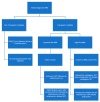Epidemiology, Staging, and Management of Multiple Myeloma
- PMID: 33498356
- PMCID: PMC7838784
- DOI: 10.3390/medsci9010003
Epidemiology, Staging, and Management of Multiple Myeloma
Abstract
Multiple myeloma (MM) is a plasma cell disorder that is on the rise throughout the world, especially in the US, Australia, and Western Europe. In the US, MM accounts for almost 2% of cancer diagnoses and over 2% of cancer deaths (more than double the global proportion). Incidence has risen by 126% globally and over 40% in the US since 1990, while global mortality has risen by 94% and US mortality has fallen by 18%. The 5 year survival in the US has more than doubled over the past decades with the introduction of new targeted therapies and transplant techniques. Risk factors for MM include age (average age of diagnosis is 69), race (African Americans are over double as likely to be diagnosed), sex (men are at a 1.5× risk), and family history. Diagnosis includes serum or urine electrophoresis and free light-chain assay but requires bone marrow biopsy. It is distinguished from smoldering myeloma and monoclonal gammopathy of undetermined significance by a high (>3 g/dL) level of M-protein (monoclonal light chains) and the presence of CRAB (Hypercalcemia, Renal failure, Anemia, Bone pain) symptoms, which include hypercalcemia, renal failure, anemia, and bone pain, suggesting an end-organ damage. International staging system staging involves beta 2 microglobulin and albumin levels, while the revised system considers prognostic factors such as lactate dehydrogenase levels and chromosomal abnormalities. Front-line management includes induction regimen, maintenance therapy and hematopoietic cell transplantation for eligible patients and bisphosphonates or bone-stimulating agents for the prevention of skeletal events. Treatment for relapsed disease includes newly approved monoclonal antibodies like the CD38-targeting daratumumab, proteasome inhibitors, immunomodulating agents, and investigational therapies such as B cell maturation antigen Chimeric antigen receptor T cells.
Keywords: diagnosis; epidemiology; etiology; incidence; mortality; multiple myeloma; risk factors; staging; treatment.
Conflict of interest statement
Alexander Barsouk served as a consultant for Bristol-Myers Squibb. The other authors declare no conflict of Interest. R.K. has received honoraria, travel funding, and research support from Illumina, Asuragen, QIAGEN, and BMS.
Figures







References
Publication types
MeSH terms
Substances
LinkOut - more resources
Full Text Sources
Other Literature Sources
Medical
Research Materials
Miscellaneous

